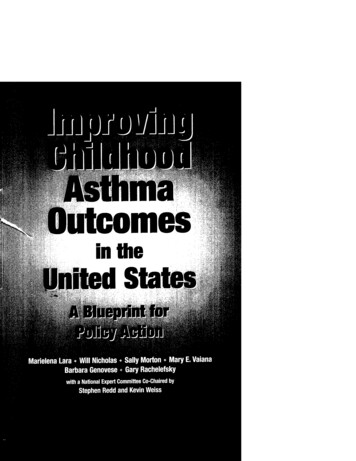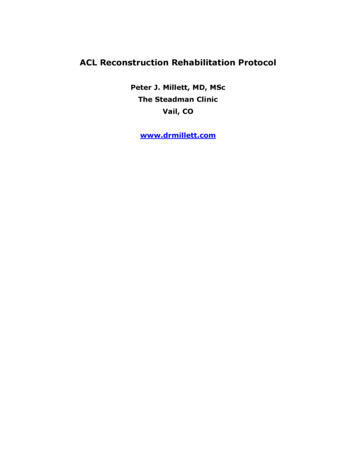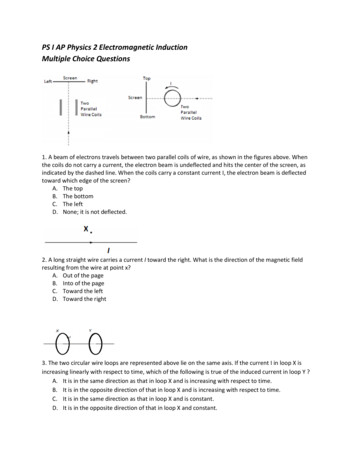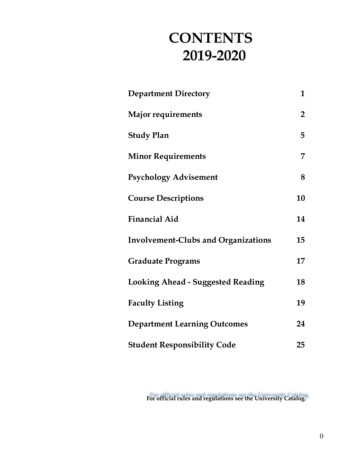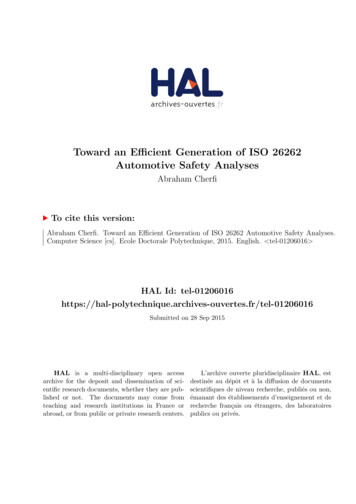
Transcription
Archives of Physical Medicine and Rehabilitationjournal homepage: www.archives-pmr.orgArchives of Physical Medicine and Rehabilitation 2016;97:2006-15SPECIAL COMMUNICATIONToward a National Initiative in Cancer Rehabilitation:Recommendations From a Subject Matter Expert GroupNicole L. Stout, DPT, CLT-LANA,a Julie K. Silver, MD,b Vishwa S. Raj, MD,cJulia Rowland, PhD,d Lynn Gerber, MD,a,e Andrea Cheville, MD, MSCE,fKirsten K. Ness, PT, PhD,g Mary Radomski, PhD, OTR/L,h Ralph Nitkin, PhD,iMichael D. Stubblefield, MD,j G. Stephen Morris, PT, PhD,k Ana Acevedo, MD,aZavera Brandon, DPT, CBIS,a Brent Braveman, PhD, OT,lSchuyler Cunningham, MSW, LICSW,m Laura Gilchrist, PhD, PT,n Lee Jones, PhD,oLynne Padgett, PhD,p Timothy Wolf, OTD, MSCI, OTR/L,q Kerri Winters-Stone, PhD,rGrace Campbell, PhD, CRRN,s Jennifer Hendricks, MSW, LCSW-C,mKaren Perkin, MEd, CTRS,a Leighton Chan, MDaFrom the aRehabilitation Medicine Department, National Institutes of Health, Clinical Center, Bethesda, MD; bHarvard Medical School, Boston,MA; cCarolinas Rehabilitation, Levine Cancer Institute, Carolinas HealthCare System, Charlotte, NC; dOffice of Cancer Survivorship, NationalCancer Institute, Rockville, MD; eGeorge Mason University, Fairfax, VA; fMayo Clinic-Rochester, Rochester, NY; gSt Jude Children’s ResearchHospital, Memphis, TN; hCourage Kenny Rehabilitation Institute, Minneapolis, MN; iNational Center for Medical Rehabilitation Research,Eunice Kennedy Shriver National Institute of Child Health and Human Development, National Institutes of Health, Rockville, MD; jKesslerInstitute for Rehabilitation Select Medical, West Orange, NJ; kWingate University, Wingate, NC; lM.D. Anderson Cancer Center, Houston, TX;mSocial Work Department, National Institutes of Health Clinical Center, Bethesda, MD; nSt. Catherine University, St. Paul, MN; oMemorial SloanKettering Cancer Center, New York, NY; pAmerican Cancer Society, Washington, DC; qUniversity of Missouri-Columbia, Columbia, MO; rOregonHealth and Science University, Portland, OR; and sUniversity of Pittsburgh School of Nursing, Pittsburgh, PA.AbstractThe health care delivery system in the United States is challenged to meet the needs of a growing population of cancer survivors. A pressing needis to optimize overall function and reduce disability in these individuals. Functional impairments and disability affect most patients during andafter disease treatment. Rehabilitation health care providers can diagnose and treat patients’ physical, psychological, and cognitive impairments inan effort to maintain or restore function, reduce symptom burden, maximize independence and improve quality of life in this medically complexpopulation. However, few care delivery models integrate comprehensive cancer rehabilitation services into the oncology care continuum. TheRehabilitation Medicine Department of the Clinical Center at the National Institutes of Health with support from the National Cancer Institute andthe National Center for Medical Rehabilitation Research convened a subject matter expert group to review current literature and practice patterns,identify opportunities and gaps regarding cancer rehabilitation and its support of oncology care, and make recommendations for future efforts thatpromote quality cancer rehabilitation care. The recommendations suggest stronger efforts toward integrating cancer rehabilitation care modelsinto oncology care from the point of diagnosis, incorporating evidence-based rehabilitation clinical assessment tools, and including rehabilitationprofessionals in shared decision-making in order to provide comprehensive cancer care and maximize the functional capabilities of cancerPresented to the Cancer Rehabilitation Symposium at the National Institutes of Health; June8-9, 2015; Bethesda, MD.Supported by the Rehabilitation Medicine Department of the Clinical Center at the National Institutesof Health (NIH), the National Cancer Institute, and the Eunice Kennedy Shriver National Institute of ChildHealth and Human Development National Center for Medical Rehabilitation Research at the NIH.The opinions expressed in this publication are not an official policy or position of the National Institutesof Health, the Department of Health and Human Services, or the U.S. Government.Disclosures: none.0003-9993/16/ 36 - see front matter ª 2016 by the American Congress of Rehabilitation 02
Cancer rehabilitation recommendations2007survivors. These recommendations aim to enable future collaborations among a variety of stakeholders to improve the delivery of high-qualitycancer care.Archives of Physical Medicine and Rehabilitation 2016;97:2006-15ª 2016 by the American Congress of Rehabilitation MedicineCancer survivors are a growing population in the United Stateswith a unique set of medical and psychosocial needs.1 These individuals frequently experience functional loss and disability as aresult of the side effects of disease and treatment.2-5 Most individuals experience cancer treatmenterelated functionalmorbidity that is amenable to rehabilitation services.6-12 However,appropriate rehabilitation services that effectively alleviate ormitigate functional impairment and prevent disability are significantly underused in all phases of cancer care.8,13 The unmet needsof cancer survivors are generally attributed to deficits incomprehensive cancer care delivery and more specifically to theproviders’ focus on achieving progression-free survival or remission rather than on maintaining function.14,15Historically, the oncology care continuum has had little intersectwith rehabilitation outside of severe disability.16 Recent calls havebeen made for this relation to be robustly developed to meet theneeds of cancer survivors.17,18 A focus on assessment and management of physical health and function is needed to promoteimproved health-related quality of life.19,20 Recommendations andstandards from the Institute of Medicine and the American Collegeof Surgeons’ Commission on Cancer, among others, provide aframework for alleviating deficits in cancer care and the resultingfailures to recognize and manage functional loss and disability.21-23Rehabilitation professionals are an optimal addition to thecancer care team and offer expertise in functional assessment,morbidity management, and disability prevention.24 Accumulatingclinical evidence suggests that rehabilitation interventions areeffective before, during, and after cancer treatment to screen for,assess, and treat patients’ functional needs.25-38 Althoughmounting evidence suggests strong benefit from the integration ofrehabilitation into the cancer continuum,39,40 there is uncertaintyaround the critical components of a model for cancer rehabilitation. Although functional assessment and measurement frameworks have been described,41 optimal functional measurementconstructs remain undefined. These issues are barriers to thesuccessful integration of rehabilitation services into the cancercare continuum.MethodsIn 2014, an appointed dissemination taskforce of the Rehabilitation Medicine Department of the Clinical Center at the NationalInstitutes of Health (NIH) was charged with identifying anemerging area of rehabilitation practice where the unique resources of the NIH Clinical Center could be leveraged to supportpractice development. The taskforce identified cancer rehabilitation as the primary area of need and recommended that the NIHClinical Center Rehabilitation Medicine Department take on afocused effort to scope (1) the evidence base and practiceList of abbreviations:NIH National Institutes of HealthPROM patient-reported outcome measureSME subject matter expertwww.archives-pmr.orgstandards supporting clinical aspects of cancer rehabilitation care,(2) gaps and needs for the field, and (3) recommendations thatcould inform key stakeholders’ future planning around nationalinitiatives in cancer rehabilitation. Based on the taskforce’s recommendations, the NIH Clinical Center Rehabilitation MedicineDepartment convened an interdisciplinary group of subject matterexperts (SMEs) in cancer rehabilitation from across the UnitedStates to participate in this exercise. The SME group included thefollowing: both internal and external NIH participants, researchersand clinical experts in cancer rehabilitation, and representationfrom the National Cancer Institute and the National Center forMedical Rehabilitation Research of the Eunice Kennedy ShriverNational Institute of Child Health and Human Development.The SME group identified 4 domains germane to understandingthe current environment of cancer rehabilitation practice in theUnited States: (1) cancer rehabilitation clinical models, (2) patientreported outcomes measures, (3) clinical objective measures offunction, and (4) interdisciplinary integration of rehabilitation.The SME group was divided into 4 smaller work groups basedon these topic areas. Individuals self-selected areas of participation based on interest and expertise. The work groups werecharged with scoping the existing environment in each domainand identifying relevant gaps in rehabilitation knowledge base andcurrent clinical practice. Systematic reviews were not practicalbecause of the varied focus within each domain and the overallscope of the project.Each group explored information of relevance to their domainthrough publications, grey literature, experience, and peer queries.Keywords and phrases were developed and agreed on withingroups to identify literature and information of interest. Individuals within each work group conducted literature searches ofrelevant information sources. Findings were shared among workgroup members, and consensus was used to identify pertinentinformation to inform recommendations. Individual work groupfindings were shared with the full SME group for further synthesis, discussion, and development of overall group recommendations. No specific mechanism for quantitative synthesiswas used.The purpose of this article is to provide the work group findings and SMEs’ key recommendations for enhancing the provisionof rehabilitation services through the cancer care continuum.Cancer rehabilitation clinical modelsPostacute carePostacute cancer rehabilitation is provided in inpatient rehabilitation facilities, skilled nursing facilities, long-term care hospitals,and hospice facilities. The rehabilitation service conducts a formalfunctional assessment to identify impairments and provides arange of services (eg, physiatry, physical therapy, occupationaltherapy, speech therapy, nutrition, psychology, nursing) to assist inoptimizing an individual’s function.42 Such programs demonstrateclinically effective care delivery and improved functional
2008outcomes that are often maintained after program completion.43-47Although the postacute rehabilitation model provides comprehensive rehabilitation services guided by a coordinated plan ofcare, this care plan is typically divorced from the oncology careplan and only in rare circumstances does one inform the other.Aside from a few specialty centers in the United States, there isnotable variation in the services provided for oncology patientsand a general lack of comprehensive rehabilitation care specific totheir unique needs.48 Additional factors that limit subacute rehabilitation services include payer limitations and provider awareness and attitudes regarding the benefits of rehabilitation.49,50Home careHome-based care models may include multiple medical andrehabilitative disciplines, but care coordination challenges impedethe comprehensive care provided in other colocated servicemodels. Home-based models are typically nurse-driven, withnursing staff providing initial assessment and treatment planning.51 Home-based nursing models focus on the consistent use ofscreening tools and clearly defined recommendations for interventions or referral. However, if home care services focusprimarily on a functional limitation, the plan of care includesphysical and occupational therapy, often without nursinginvolvement. Because of the uncertainty of provider roles andexpertise, well-articulated cancer-specific care components shouldbe a part of comprehensive cancer care plans, rather than beattributed to an individual practitioner’s role. Lacking in thismodel is a concerted effort to identify the unique and additionalneeds of cancer patients with regard to screening, intervention,and follow-up for cancer treatmenterelated morbidity and toxicities that affect function.52Outpatient ambulatory careConsistent, comprehensive care in the outpatient setting is alogical extension of the postacute model and complements thedelivery of outpatient ambulatory oncology care through functional screening and monitoring for late effects and providinginterdisciplinary intervention to alleviate functional deficits.Outpatient ambulatory models for cancer rehabilitation care areclinically effective,53,54 promote identification and management oftreatment toxicities that affect function,25,26,55-58 and demonstratepositive effect on functional outcomes.24,37,39,59Multidimensional rehabilitation program models strive toaddress both physical and emotional needs of patients. A multidimensional approach is more likely to help patients cope withtheir physical needs.60 Multidimensional rehabilitation programmodels involve interval face-to-face and phone contact between apatient and a rehabilitation health professional (eg, physiatrist,nurse, physical or occupational therapist).60Ambulatory cancer rehabilitation programs however have widevariance in the service offerings and little consistency as to thetiming of intervention, coordination with other medical providers,coordination with the cancer care plan, and follow-up. Adaptationof the cardiac rehabilitation model for use in oncology rehabilitation has been suggested as a model61,62 because the tenants ofcardiac rehabilitation, including rehabilitation, treatment sequelaemanagement, and healthy lifestyle development,63 are common tooncology rehabilitation. However, limited data are available tosupport this approach. Emerging evidence supports the geriatricmodel of care and geriatric assessment as a framework that couldN.L. Stout et alguide rehabilitation screening, assessment, and intervention in theambulatory care setting for the cancer population.11,64 The mainfeatures of this model, including the focused attention to interdisciplinary input, the inclusion of nonmedical domains (eg, caregiverstatus, home environment assessment), and the emphasis on functional capacity and quality of life, make this an ideal framework toportray a holistic view of the many aspects of an individual’s lifethat contribute to their overall functioning. Further work andresearch is needed by the rehabilitation community to identify andincorporate supportive elements of the geriatric care model.Models for cancer rehabilitation exist across the United States,but no consensus exists on the core components that comprisecomprehensive cancer rehabilitation. Shortcomings with theseprograms are that they are narrow in scope, focusing on one aspectof individual care, and neglect to provide the full range of servicesneeded to restore function for the cancer survivor.65 Many programs fail to provide comprehensive, interdisciplinary assessmentand intervention, and the workforce may be minimally trained toaddress the complex needs of the cancer population. Further, thesemodels fail to address the essential components of survivorshipcare plans as articulated by policy bodies.Cancer survivorship care plans outline the critical componentsof cancer care that should be documented and provided to thepatient and the health care team during and after the continuum ofcancer treatment.22 Additional elements, including psychosocialcare, symptom management, and health promotion, augmentcomprehensive care.66 Rehabilitation is a logical supportive service that compliments and integrates with a survivorship care planand potentially serves as a point of quality improvement byenhancing functional outcomes.67,68 Further, rehabilitation services are reimbursable events, making the model of interventionsustainable.An improved care model would provide rehabilitation servicesspecific to the patients’ needs, improve communication and carecoordination between oncology and rehabilitation providers, andreduce variations in care among practice settings.17,69,70 Thiswould include proactive impairment screening and functionalassessments throughout the care continuum relevant to the adjuvant therapy rendered. It would support intervention for overtfunctional impairment and provide ongoing supportive services inthe presence of disability. The model could serve as a linkage inthe care continuum to support monitoring for treatment toxicitiesand late effects in addition to optimizing function throughout thelife span.71Clinical measurement of functionCancer treatment introduces risk for functional impairments thatincrease the potential for disability. In order to accurately screenfor and manage functional impairments related to treatment toxicities, a battery of functional measurement tools must be identified. Robust evidence supports specific measures of functionalimpairment in the cancer population72-76; however, these individual measures fall short of comprehensively assessing function.Function is defined as “those activities identified by the individualas essential to support physical, social, and psychological wellbeing.”77(p18)Measures of function are derived primarily in 2 ways: (1)patient-reported outcome measures (PROMs) and (2) objectiveclinical tests and measures. These methodologies however arefrequently conflicted. Although objective clinical measures maywww.archives-pmr.org
Cancer rehabilitation recommendationsfail to capture the patient’s perceptions of his or her level offunction, reliance on PROMs often does not portray a holisticperspective on the individual’s function nor does it identifyemerging impairments associated with functional decline. Ideally,the application of objective measures alongside PROMs providesbroader perspective on total functioning of the individual.78Patient-reported outcomes measuresA patient’s perception of his or her own functionality is a criticalclinical outcome. The current mandate to integrate the patient’svoice into clinical decision-making in oncology has increasedreceptivity to the use of PROMs in both clinical and researchsettings.79 PROMs with strong validity and good clinical utilitycan be inexpensively administered, making them amenable tointegration into busy oncology practice settings.PROMs have a wide range of application and clinical relevancein cancer populations and are effective in toxicity screening andfunctional outcomes assessment.41 Additionally, well-developedand targeted PROMs may efficiently assess important end points(eg, quality of life, survival).80 Both generic and disease-specificPROMs are used to assess the functionality of patients with cancer.81,82 Increasingly efficient and precise item response theoryederived instruments, such as the Activity Measure for Post-acuteCare (available at: http://www.bu.edu/bostonroc/instruments/ampac/) and the Patient Reported Outcome Measurement Information System (available at: http://www.nihpromis.org/), allow forthe pragmatic integration of functional assessment in oncologyclinic work flows and clinical trials.The content coverage of several generic classical test theoryeand item response theoryederived functional PROMs was assessedusing the International Classification of Functioning, Disabilityand Health (available at: http://www.who.int/classifications/icf/icf more/en/) as a referent framework of functional domains. Thetools reviewed are presented in appendix 1. Although most of themeasures provided coverage of mobility and self-care domains, thecommunication, learning, work/employment, and community andsocial participation domains were limited in representation. Thisimbalance in and restriction of domains contributes to inaccurateassessments of global functioning. Therefore, consideration for theuse of established item response theoryemodeled PROMs, such asthe Patient Reported Outcome Measurement InformationSystem and Neuro-QoL (available at: /Pages/default.aspx), itemsbanks is warranted.Recent evidence suggests that PROMs are less effective thanobjective assessment tools in identifying individuals who arefunctionally limited compared with those not experiencing functional limitations.83 This suggests a high risk for underdiagnosis ofclinically meaningful functional limitations, a concern for thecancer population, because early identification and treatment offunctional limitations reduce the risk for long-term disability.84,85Future research in functional measurement should seek tocombine PROMs and objective measures to identify optimalmethodology for measurement.Clinical objective measures of functionHigh-level domains of clinical function are supported by a discreteevidence base; however, there are considerable gaps in the clinicalwww.archives-pmr.org2009utility of functional objective measures relevant to the cancerpopulation.Physical performance/fitnessPhysical performance measures can identify and predict adverseevents, disability, and mortality in the adult population.86-88Physical performance can be assessed by a single measure (eg,gait speed86) or a battery of assessments that effectively captureclinical symptom presentation and predict risk of disabilityand death.89Diminished physical performance is associated with cancertreatment.90 The consistent use of valid, reliable, performancemeasures is rare in the oncologic clinical setting outside of rudimentary scales, such as The Eastern Cooperative Oncology Groupor the Karnofsky Performance Scale, both of which fall short ofportraying an individual’s discrete functional capabilities.78,91 TheKarnofsky Performance Scale is a predictor of overall survival, butit is inadequately sensitive to identify clinically meaningfulimprovement in function over time. Recent evidence highlightsthe potential for the geriatric assessment, as described by Elsawyand Higgins,92 to be a more sensitive screening tool for theidentification of treatment-related toxicities. The geriatric assessment “aids in the diagnosis of medical conditions; development oftreatment and follow-up plans; coordination of management ofcare; and evaluation of long-term care needs and optimal placement.”93(p397) The domains of the geriatric assessment include thefollowing: functional status, comorbidity, medication, cognition,psychological, social, and nutrition. Hurria et al94 have outlinedvalid clinical measures and patient self-reported measures relevantto each of these domains. Such a measurement construct is alogical linkage between rehabilitation and oncology care servicesand warrants further investigation in the cancer population.Cognitive performanceThe assessment of cognitive function during cancer treatment isdemonstrably important; however, the conundrum of poorconcordance with self-reported measures and objective clinicalmeasures is apparent in this domain as well.95 Subjective cognitive impairment is more frequently reported than prevalence ratesrevealed by objective assessments. It is uncertain if this is becauseof the lack of sensitivity in existing cognitive measures whenapplied to the cancer population or if the self-perceived cognitivedysfunction is more of an indicator of psychological distress ratherthan cognitive impairment.96Strong research has emerged in the cognitive measurementdomain.97 The National Comprehensive Cancer Network’sguidelines98 for survivorship recommend assessment, evaluation,and management for cognitive dysfunction. Among the recommended nonpharmacologic interventions, referral for rehabilitation intervention by occupational therapists is noted.98 Recentresearch has proposed a mobile cognitive assessment battery forassessment of cancer-related cognitive changes.99,100There is a need to better integrate cognitive assessment for thecancer population.101 Evidence suggests that preexisting cognitiveimpairment, in many instances mild or subclinical, may beexacerbated during cancer treatment.102 Therefore, a comprehensive cancer rehabilitation model that includes prehabilitation orpretreatment assessment should seek to establish a cognitivebaseline to optimize proactive screening.103
2010Functional mobilityMobility is an important aspect of function; however, tools thatmeasure mobility struggle to find their place in the cancer continuum for a variety of reasons. Assessments require a time burden,they may be proprietary and not readily available in a clinicalsetting, and there may be a lack of knowledge among providersabout relevant mobility measures for the cancer population.Recent advances in mobility assessment in the geriatric population have yielded comprehensive assessment tools that warrantconsideration for implementation into the cancer rehabilitationevaluation and assessment battery.104 Instruments typically used inthe geriatric population are likely to offer important informationabout functional ambulation (timed Up and Go test, 6-minute walkdistance, and others) and balance.105-107Measurement challengesMeasurement challenges go beyond the psychometrics and validity of tools. Geographic location may prohibit functionalassessment in patients who need to travel long distances. Technology tools (eg, activity monitors, apps, social media platforms)should be investigated as a mechanism to assist in telehealthscreening and assessment.108 These tools can capture and monitornutritional data, activity and exercise data, sleep behavior, vitalsigns, and psychological information and can portray social activities. Although public acceptance of these tools has been positive, medical disciplines have only just begun to explore theirrelevance and accuracy in monitoring and communicating an individuals’ data, and there is merit to studying their utility infunctional assessment.Health care provider perceptions of function also pose achallenge to proactive functional measurement. Individuals arediagnosed with cancer in an inherently normative functional state,when the urgency of functional decline is not apparent. The trajectory of cancer treatment precipitates a somewhat gradualdecline in function as the cumulative side effects of diseasetreatment aggregate. The gradual onset of functional decline willonly be identified if a sound baseline is established and individualsare routinely screened for clinically meaningful functional changethroughout the trajectory of treatment.39Both PROMs and objective tests and measures can be used toestablish a baseline from which change over time is assessed.Repeated measures enable screening for treatment-related toxicities. Although initial efforts in toxicity-related impairmentscreening and early intervention have been positive, there is a needto greatly expand this research.25,26,109 There is a need to understand which measures are most useful for screening and earlydetection of functional decline and to specify intervals for measurement, clinically meaningful change, and triage protocols forintervention on detection of meaningful change.Interdisciplinary clinical integration ofrehabilitationIntegrated care models rely on a team of health care professionalsthat share patient care goals and interact on a care continuum. Thisincludes individualized consultative, interventional, and integrative services.110 Integrated models are used in cancer care fromthe point of diagnosis through disease treatment and becomeparticularly critical in transition from active disease treatment toN.L. Stout et alsurvivorship.111 These models however conspicuously lack rehabilitation care providers.Cancer rehabilitation care supports the provision of highquality oncology services.4,17 Despite the recognized andgrowing need for interdisciplinary cancer rehabilitation services, significant gaps in service delivery currently exist.4,8,11These gaps negatively influence function, quality of life,health status, and ability to return to the workforce.40,85 Integration of cancer rehabilitation services ideally begins at thepoint of cancer diagnosis, with baseline functional screening39and referral for prehabilitation interventions.71 Ongoing rehabilitation assessment and management across the care continuum is also important.24 Mechanisms are need to facilitatebetter clinical integration of cancer rehabilitation care using abest practices approach, based on the current evidence andexpertise of rehabilitation providers.Barriers to rehabilitation integration into oncology care include(1) insufficient capacity of the existing workforce, (2) challenges inscreening for rehabilitation needs, and (3) lack of awareness amongpatients and caregivers regarding the benefits of rehabilitation.Various inputs contribute to the lack of capacity, including thenumber of specialty trained rehabilitation professionals and a lackof knowledge among the existing workforce regarding evidencebased cancer rehabilitation care. A survey of the U.S. workforce incancer rehabilitation was conducted in 1982 by Harvey et al112and identified 36 cancer programs that reportedly provided components of cancer rehabilitation services. Recent unpublishedworkforce data released by the Oncology Section AmericanPhysical Therapy Association reports that an estimated 5%(approximately 9000) of the currently licensed physical therapyworkforce (approximately 182,000) in the country primarilypractice in a cancer rehabilitation program. (Oncology SectionAmerican Physical Therapy Association, 2016; available at: list Certification/New Speciality/OncologyPetition.pdf). Over 1500 cancer centersare accredited
Rehabilitation Medicine Department of the Clinical Center at the National Institutes of Health with support from the National Cancer Institute and the National Center for Medical Rehabilitation Research convened a subject matter expert group to review current literature and practice patterns,


